[Sorry for the clunky format -- not a professional blogger. Click on the pix to see a larger view.]
The first day we drove all the way from Orange County, California, down past San Quintin [mostly agricultural], and into the desert to El Rosario, about halfway down (a total of 350 miles). We went much further than we had expected, and the roads were in excellent condition (albeit rather frighteningly narrow -- passing the occasional slow truck was a white knuckle experience). I can highly recommend Cafe Jalisco in Maneadero (handmade corn tortillas!), and Mama Espinosa’s in El Rosario (scallops and fish in garlic sauce!). We stayed in Baja Cactus in El Rosario, which was quite nice (but which did not have any heat).
The second day we drove through some serious desert (cacti of all descriptions and shapes) to San Ignacio, another 350 miles. The drive was surprisingly interesting and pleasant. At San Ignacio (an actual date palm oasis!), we stopped in at the Kuyima whale watching office in town; fortunately, due to a last-minute cancellation, we got a "room" right on the lagoon in one of the cabanas. (Ordinarily, reservations are crucial during the whale season, but we didn’t really know when we were going or when we would arrive; we were prepared to camp, if necessary.) The last hour of the journey down to the ocean was jolting over a really rough rocky dirt road in our Nissan Pathfinder 4x4, which was a lot of fun (really). I wouldn’t take an ordinary passenger car on this road.
The lagoon itself is a huge and deep bay, cut into the flat desert. The desert in this area is amazingly dry, much drier than the Mojave. There's almost nothing growing in the sand. The encampment at the lagoon consisted of perhaps a dozen little 10 x 10 huts on the beach, plus a communal dining palapa.
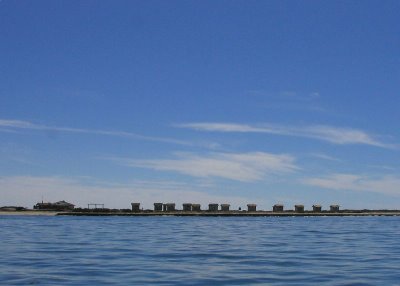
This is the whole camp, as seen from the bay.
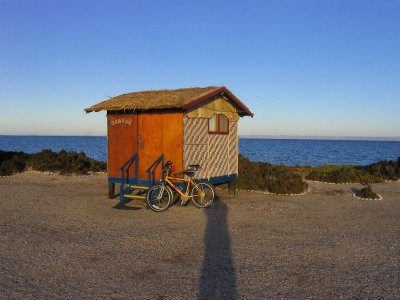
This is our hut. Very modest.
The outhouses (and the outdoor showers, with solar heated water) were only a short walk away. Everything in this encampment was very ecologically correct, from the composting toilets to the wind-turbine powered electrical system.
As we were carrying our stuff to the cabin, we heard these loud whooshing noises, which turned out to be whales spouting in the lagoon just behind us. We took a long bike ride in a psychedelic sunset, followed by a long after-dinner walk through a warm desert wind, under the most brilliant stars (by far) that I have ever seen in 54 years of fairly avid stargazing.
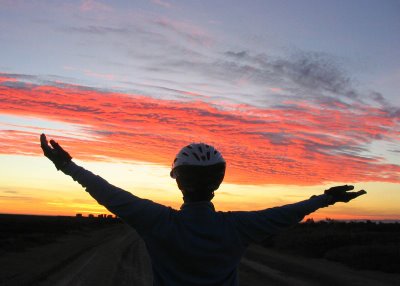

The third morning was very calm. We took a ride with a guide in a panga [skiff] out onto the lagoon. We were surrounded by whales on all sides, blowing, breaching, rolling, fluking, spy hopping, and mating (rather explicitly!). It was mind-boggling and overwhelming. It got to the point where we wouldn't take a picture unless it included both (e.g.) a whale blowing and a whale spy hopping. Single behaviors were just too common to photograph.

This is spyhopping.
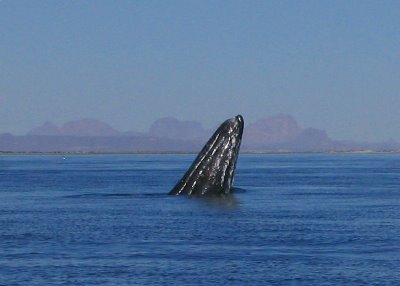
More spyhopping, with the desert mountains in the background.
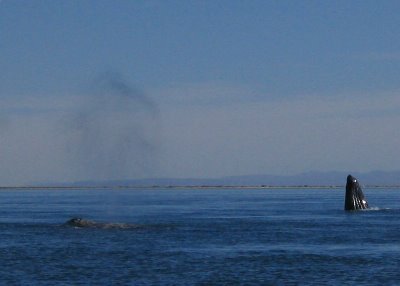
More spyhopping, this time with another whale spouting on the left side.
After lunch, we went out again, hoping to see mothers and their babies (which we hadn't seen during the morning). Sure enough, we saw several pairs.
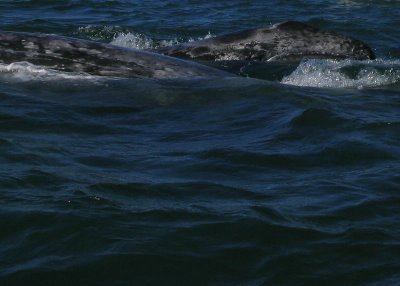
Here's a Mom and a baby.
When we would spot them, we would splash the water, and they would swim toward the boat. The mother would seemingly encourage the baby to come toward the boat to be petted. One baby finally summoned up enough courage to do so.
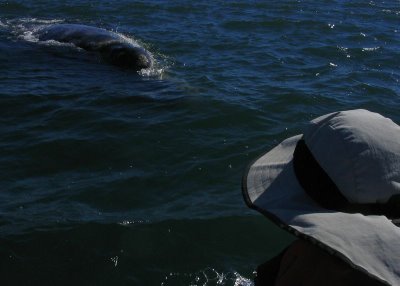
He's heading for the boat.

He swam right to my wife, and she petted his skin. She said that it felt like soft wet leather. As you can imagine, she was excited out of her mind (the wife, not the baby).
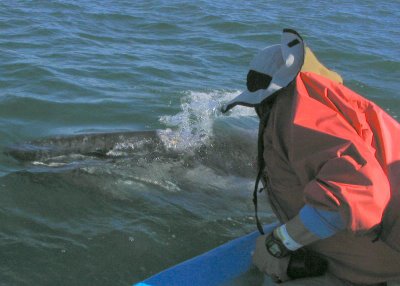



No one has any idea why the whales encourage the babies to approach the boats. It doesn't make any sense. Perhaps they enjoy being scratched.
Late that afternoon, we drove back to San Ignacio and stayed in an extremely modest motel (La Posada), which was clean but threadbare. We ate dinner at Renee’s (more scallops and fish in garlic sauce), and breakfast at Tota’s (good Mexican eggs and omelettes).
On the fourth day, we drove to Bahia de Los Angeles, on the Gulf of California side, about 250 miles away. Again, the roads were surprisingly good, and we had no trouble finding gas (which we had been told was going to be difficult). The bay itself was very beautiful, with deep blue water and pink islands scattered offshore. We stayed in another decent motel (Costa del Sol) and took a couple of long bike rides on dirt roads on the hills overlooking the Gulf.

We ate at Las Hamacas and La Palapa (more seafood in garlic sauce). The next morning, we had breakfast north of town at Raquel and Larry’s, a modest but pleasant hotel right on the beach. They have a great shaded upstairs patio for meals -- very pleasant.

This makes it look like we did a lot of sitting around and relaxing. We didn't, but Bahia de Los Angeles is a great place for folks who are good relaxers.
At that point, we could have continued up the Gulf Coast on a series of very difficult [i.e., fun] dirt roads. But we discovered that since we don't fish or dive, there isn't a whole lot to do on that side of the peninsula, and the desert scenery (although interesting) gets to be kind of the same after a few days of driving around. I would guess that folks who like to fish or dive would find the Gulf side really wonderful.
On the fifth day, we headed back to the Pacific side and drove another 250 miles up to San Vicente, 50 or 60 miles south of Ensenada, and stayed in yet another extremely modest motel (La Palma). We stayed there because we wanted to go on a scouting mission down to the coast near Erendira on the sixth day, because we had heard that there were some great surfing beaches in that area, with RV parks suitable for our trailer (which we had left at home in Orange County).
As it turns out, the surfing beaches were pretty good, although somewhat rocky, but the RV parks were nonexistent or too squalid. (At one point, we took a wrong turn because the road to one of the alleged parks was unmarked, and I ended up having to drive the Pathfinder down some very narrow and rocky pathways to get back to the main "road." It was a blast.)
In the same area, north of Punta Isidro, we took an astonishing bike ride on a series of dirt roads that skirted the edge of cliffs above the ocean. This was a brilliantly clear and windy day just after a storm front had passed, and the waves were huge, crashing against the craggy shoreline. Imagine the Monterey, California, coastline, utterly deserted, with miles of mountain-bike-accessible trails and roads at the edge of the water, and you will have some idea of how wild and exhilarating this area was. There were a few houses and farms scattered every few miles, but this was essentially what the coast of California must have looked like 500 years ago. We then drove home on the evening of the sixth day.

Overall, some of the pluses and minuses: the food throughout the whole trip was really excellent. Most of the time, we ordered various types of seafood al mojo de ajo -- sautéed in garlic. We had no stomach problems, even though we ate whatever we wanted. (On the advice of my brother, a doctor, we took two Pepto tablets before every meal!) We even ate fresh dates in San Ignacio (fabulous) and coconut ice cream bars in San Vicente (also great).
The people were very friendly, and the villages were picturesque (dogs sleeping in the dust in the middle of the street). On the downside, the villages were very dirty and poor (dogs sleeping in the dust in the middle of the street). There was trash strewn everywhere, and rusted out hulks of cars and trucks litter the sides of the roads.
Although the roads themselves were in surprisingly good condition, they were really narrow, with absolutely no shoulder, and no passing lanes. When (for example) an RV and a semi truck are passing each other, there is only about 18 inches or less between the two of them. If you have to drive off the shoulder at high speed, your car will roll over, since the drop from the pavement to the dirt is often as much as a foot. In other words, for over 1000 miles, this highway is much trickier than the very worst parts of Highway 395, a notoriously dangerous California road. Your attention can't waver for a moment.
A couple of times, we had minor law enforcement problems. Once, when we crossed the 28th parallel, there was an inspection station, and one of the officers told us that our papers (which we had obtained in Tijuana) were not in order and that we would have to go to a bank to pay for new papers. But we managed to talk him out of that. Another time, I went to pass a truck at very low speed that I thought was turning off the road, and a cop by the side of the road waved me over for crossing over the unbroken centerline. He told us that he would have to hold my license, that I would have to go to Ensenada (100 miles away) to pay a fine, and I would have to come back to get my license. When I told him I wanted to look up the procedures for doing so in materials sent to me by the "sindicatura" (i.e., the agency directed at investigating corruption), he suddenly changed his mind and said that he would let me off with a warning. (I think that he wanted me to offer him a payoff, in lieu of a trip to Ensenada.)
I would recommend that anyone taking a trip of this nature should carry several different guidebooks. We had the Walt Peterson book, the Moon guidebook, the AAA book, and the Baja Almanac, which has very detailed topographic maps. We used all of these reference tools, again and again. Each book told us something different; we put the information all together, and we got a really good picture of where we were going and what was available. I also had a GPS with us, but I never had occasion to use it. It was nice to know that it was available, however.
The same is true for all of my survival gear (a shovel, a jack, tools, tow ropes, etc.). I never got stuck, but I was more comfortable simply because I had it all with me.
Overall, I doubt that we will do this particular trip again, mostly because it involves so much driving and so much desert scenery. However, we will probably go to Northwestern Baja again; some of the beaches were very inviting. For those of you who are put off by the poverty or crime or possible law enforcement problems, I would urge you not to give in to your fears. If you take proper precautions, and you obey the law, and you drive sensibly, and your car is properly equipped, you should encounter no problems that you are unable to handle.
1 comment:
Dan,
Great writeup. We've stayed twice at Kuyima's other camp- which is a campground about a mile closer to the airport.
The first time we left Long Beach the week after picking up our brand new Chalet trailer. Unfortunately Chalet only used eight 1/4" self-tapping screws to hold the body to frame. Guess what happens to self-tapping screws on washboard road? The body came loose from frame. Then after fixing that we broke both leaf springs.
Since then our trailer has upgraded springs, shock absorbers, more screws plus it's through-bolted in 10 places.
Post a Comment